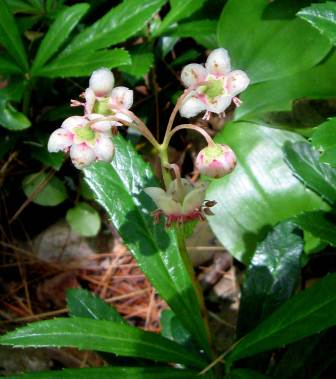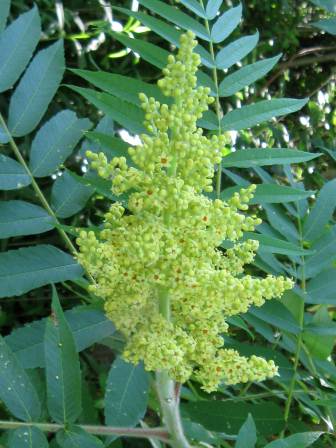I saw a hillside covered in lupines recently. They aren’t our native sundial lupines (Lupinus perennis) but they’re still very beautiful when massed like this.
At the bottom of the hill that the lupines were growing on many native blue flag iris (Iris versicolor) grew in a wet area. The lupines trickling down the hillside and the blue flags pooling at the bottom made a breathtakingly beautiful sight but unfortunately I couldn’t get in all in one photo.
Gosh these are beautiful flowers; another one of those flowers that I can just sit beside and lose myself in. The name flag is from the Middle English flagge, which means rush or reed and which I assume applies to the cattail like leaves. Though Native Americans used this plant medicinally its roots are considered dangerously toxic. Natives showed early settlers how to use small amounts of dried root safely as a cathartic and diuretic.
Each strap shaped, yellow “petal” on a yellow hawkweed flower head (Hieracium caespitosum) is actually a single, complete flower and each forms its own seed. The buds, stem, and leaves of the plant are all very hairy and the rosette of oval, overlapping leaves at the base of the stem often turn deep purple in winter. The Ancient Greeks believed that hawks drank the sap of this plant to keep their eyesight sharp and so they named it hierax, which means hawk. It is an introduced invasive and names like “yellow devil” and “devil’s paintbrush” show what ranchers think of it.
Native maple leaf viburnum blossoms (Viburnum acerifolium) had just about gone by before I remembered to look for them. Each flattish flower head is made up of many small, quarter inch, not very showy white flowers. If pollinated each flower will become a small deep purple berry (drupe) that birds love to eat. What I like most about this little shrub is how its leaves turn so many colors in fall. They can be pink, purple, red, yellow, and orange and combinations of two or three, and are really beautiful. The Native American Chippewa tribe used the inner bark of this plant to relieve stomach pains.
The puffy little yellow blossoms of bird’s foot trefoil (Lotus corniculatus) are a common sight along roadsides and waste areas. It is in the pea family and grows about a foot tall. It gets its common name from its clusters of brown, 1 inch long seed pods which someone thought looked like a bird’s foot. The plant has 3 leaflets much like clover and was introduced from Europe as livestock feed but has escaped and is now considered invasive in many areas. It can form large mats that choke out natives. It does very well among the ox eye daisies and lupines growing along the banks of the Ashuelot River.
I found a spot where more blue eyed grass (Sisyrinchium angustifolium) grew than I’ve ever seen in one spot. They were growing in soil that was on the sandy side in full sun along the side of a road, and obviously were happy there. Wild turkeys love the seeds so I wouldn’t be surprised to see a flock of them here this fall.
I’ve already featured blue eyed grass once this spring but something this beautiful deserves a second showing. This little flower is in the iris family and is said to have the same features. All of the iris family is usually thought of as very poisonous but Native Americans had many medicinal uses for this plant.
Red clover (Trifolium pretense) always seems to glow as if it had its own inner light, and maybe it does. The rounded heads of tiny tubular flowers are beautiful things to see when you take the time to give them a closer look. Though it was brought to this country from Europe and is invasive, I can’t remember ever hearing anyone complain about it. It is a very old medicinal herb that has been used for centuries and now various published studies say that compounds found in the plant show some promise in fighting cancer. Just imagine all the healing power that might be in these plants that hardly get a second look.
Multiflora rose (Rosa multiflora) has beautiful small white (rarely pink) flowers that are about an inch across but unfortunately it is very invasive and forms prickly thickets that nobody I know would dare to try and get through. It is from Japan and Korea and grows to huge proportions, arching up over shrubs and sometimes growing 20-30 feet up into trees. A large plant bearing hundreds of blossoms is a truly beautiful thing but its thorny thickets prevent all but the smallest animals from getting where they want to go. Its sale is banned in New Hampshire but since each plant can easily produce half a million seeds I think it’s here to stay.
I always find wild radish (Raphanus raphanistrum) growing at the edges of corn fields at this time of year, not because it likes growing with corn but because it likes to grow in disturbed soil. Wild radish is in the mustard family and is sometimes confused with wild mustard (Brassica kaber,) but that plant doesn’t have hairy stems like wild radish. Everyone seems to agree that this is a non-native plant but nobody seems to know exactly where it came from or how it got here. The flowers can be pale yellow, pink, or white and honey bees seem to love them no matter what color they are.
I am always reminded each spring that one of the great delights of wandering in the New Hampshire woods is the amazing fragrance of wild grape flowers that wafts on the breeze. Their perfume can be detected from quite a distance so I usually let my nose lead me to them.
I’m always surprised that such a big scent comes from such tiny flowers, each no bigger than the head of a match. Each will become a grape when pollinated. We have a few varieties of wild grape here in New Hampshire including fox grapes (Vitis fruitlabrusca), and frost or river grapes (Vitis riparia.) The fruit is an important food source for everything from birds to bears.
Smooth arrowwood (Viburnum dentatum) has yellowish white, mounded flower clusters and is blooming along stream banks and drainage ditches right now. Red twig dogwoods are also beginning to bloom, but they have four petals and the viburnums have five. Dogwood flower clusters also tend to be much flatter on top and seem to hover just above the branch. Smooth arrowwood viburnum has a much more rounded flowering habit. Later on the flowers will become dark blue drupes that birds love. It is said that this plant’s common name comes from Native Americans using the straight stems for arrow shafts. They also used the shrub medicinally and its fruit for food.
Star chickweed (Stellaria pubera) has 5 white petals so deeply notched they look like 10. At one half inch across they are bigger and showier than other chickweeds, but still quite small. Even so, other common names include giant chickweed and great chickweed. It is an introduced plant, most likely brought from Europe where it has been used medicinally since ancient times. Legend says that if its blossoms are open there will be at least 4 more hours without rain. If the blossoms close, rain is coming. I’m hoping to see open chickweed blossoms this morning.
Flowers have spoken to me more than I can tell in written words. They are the hieroglyphics of angels, loved by all men for the beauty of their character, though few can decipher even fragments of their meaning. ~ Lydia M. Child
Thanks for stopping in.






















































